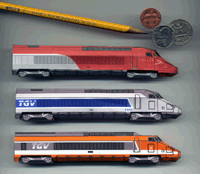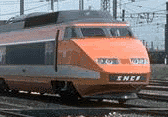|
|
|
TGVweb > TGV Models > Build Your Own |
Serve this page from: California, USA / Pisa, Italy |
Print, Cut Out and Assemble your own scale models of the TGV!
The TGV models offered here are fairly easy to build. Even if this is your first card model, patience and good care will ensure a good result. Each vehicle takes about 30 minutes to an hour to build, so a full TGV trainset will take you 5 or 6 hours to finish. Take your time, take breaks, and be patient; the result is worth your effort! Younger kids might need a little bit of help.
Available Models
- TGV PSE (Paris Sud-Est) original orange version
- TGV PSE (Paris Sud-Est) blue Ligne de Coeur version
- TGV La Poste
- TGV Atlantique
- TGV Thalys
- TGV Duplex
- AVE / Euromed (Spanish TGV)
- KTX (Korean TGV)
- Speedrail (Australian TGV)
- Acela Express (USA)
- Undecorated TGV
The models are approximately 1/140 scale (1 meter = 20 pixels) if printed out at the normal screen resolution of 72 dpi. A complete TGV trainset will be about 1.5 meters (5 feet) long and about 2.5 cm (1 inch) tall.

Click to view photo, or see more finished models by readers of these pages.The supplies you will need are:
- Color printer
- Premium quality paper, weight 100 g/m2 (26 lbs) or higher strongly recommended
- Scissors, or a sharp X-Acto knife
- White glue
- Dead ballpoint pen (for scoring folds)
- Ruler
- Well-lit area with a comfortable seat
- Patience!
To get started, select the model you want to build below, and make sure to read these IMPORTANT GENERAL INSTRUCTIONS before you begin. Another excellent resource on how to make paper models is the Card Modeling FAQ by Steve Brown. You can also see some pictures of models that were built by readers of these pages. If you want, send me a picture of your TGV model and I will add it.
If you have any trouble or if something is wrong with the instructions, please tell me.
Display Track
Print out some high speed track to display your TGV models.
TGV PSE (Paris Sud-Est)


This is the original TGV, in two separate versions. The first (orange and gray colors) represents the original colors of the first TGV trainsets. The second (blue and gray) is a model of trainset 110 after renovation for the Ligne de Coeur service to Switzerland. Tri-voltage trainsets such as 110 are now distinguished by a red window band. Select the links below to view and print the parts sheets, making sure to read the corresponding instruction sheet before starting.
Orange Version
Parts SheetBlue Version
Parts SheetAssembly
InstructionsRelative
DifficultyPower Car Power Car Instructions More Difficult R1 (1st class) R1 (1st class) Instructions Difficult R2, R3 (1st class) R2, R3 (1st class) Instructions Easy R4 (Bar) R4 (Bar) Instructions Easier R5, R6, R7 (2nd class) R5, R6, R7 (2nd class) Instructions Easy R8 (2nd class) R8 (2nd class) Instructions Difficult Put your trainset together in the following order: 1 Power Car, trailers R1 to R8, and the second Power Car. See TGV trainset formations for more detail. If you're short on time (or patience) you can make a shorter trainset by deleting one or more of the R2, R3, R5, R6 and R7 trailers. You could even make a model of orange trainset 16, which had only 5 trailers (see formations) during the speed record run of 1981. Visit finished models to see the result.
TGV La Poste
This is the postal TGV, in the colors of the French postal service. For a full trainset, you will need two Power Cars, two end trailers, two intermediate trailers with the big logo, and four intermediate trailers without the big logo. Select the links below to view and print the parts sheets, making sure to read the corresponding instruction sheet before starting.
Parts Sheet Assembly Instructions Relative Difficulty Power Car Instructions More Difficult End Trailer Instructions Difficult Intermediate Trailer, with logo Instructions Easy Intermediate Trailer, no logo Instructions Easy Put your trainset together in the following order: 1 Power Car, 1 end trailer, 1 trailer without logo, 1 trailer with logo, 2 trailers without logo, 1 trailer with logo, 1 trailer without logo, 1 end trailer, and the other Power Car. You should end up with one set of wheels too many, which you can discard. Visit finished models to see the result.
TGV Atlantique
This is a second generation TGV, introduced in 1989, in blue and silver colors. For a full trainset, you will need two Power Cars, one second class end trailer, five second class intermediate trailers, one bar trailer, two first class intermediate trailers and one first class end trailer. Select the links below to view and print the parts sheets, making sure to read the corresponding instruction sheet before starting.
Parts Sheet Assembly Instructions Relative Difficulty Power Car Instructions More Difficult 1st Class End Trailer Instructions Difficult 1st Class Intermediate Trailer Instructions Easy Bar Trailer Instructions Easier 2nd Class Intermediate Trailer Instructions Easy 2nd Class End Trailer Instructions Difficult Put your trainset together in the following order: 1 Power Car, 1 first class end trailer, 2 intermediate trailers (1st class), 1 bar trailer, 5 intermediate trailers (2nd class), 1 second class end trailer, 1 Power Car. See TGV trainset formations for more detail. If you're short on time (or patience) you can make a shorter trainset by deleting some of the intermediate trailers. You could even make a model of the world's fastest train, TGV Atlantique trainset 325, which had only 3 trailers during the speed record runs of spring 1990 (one 1st class end trailer, a bar trailer, and a 2nd class end trailer). Visit finished models to see the result.
AVE / Euromed (Spanish TGV)
These are two Spanish high speed trains, in blue and white colors. You can build either version (the standard gauge AVE or the broad gauge Euromed). For a full trainset, you will need two Power Cars, one second class end trailer, three second class intermediate trailers, one bar trailer, two first class intermediate trailers and one first class end trailer. Both of these TGV versions were contributed to TGVweb by Michel Bolman. Select the links below to view and print the parts sheets, making sure to read the corresponding instruction sheet before starting.
AVE
Parts SheetEuromed
Parts SheetAssembly
InstructionsRelative
DifficultyPower Car Power Car Instructions More Difficult R1 (1st class) R1 (1st class) Instructions Difficult R2, R3 (1st class) R2, R3 (1st class) Instructions Easy R4 (bar) R4 (bar) Instructions Easier R5, R6, R7 (2nd class) R5, R6, R7 (2nd class) Instructions Easy R8 (2nd class) R8 (2nd class) Instructions Difficult Put your trainset together in the following order: 1 Power Car, trailers R1 to R8, 1 Power Car.
KTX (TGV Korea)
This is the KTX (Korea Train Express). It has 18 trailers, so maybe you won't want to build all of them! For a full trainset, assemble one Power Car, MT1, T2, T3, T4, ... , T17, MT18 and the second Power Car. If you want to build a shorter trainset, you can reduce the trailers to MT1, T2, T3, T6, T15, MT2. I wish to thank Tanguy Couvrat-Desvergnes and Mr. Son of KTX for their help in getting the details right. You can find out more about the KTX project in the links page.
Parts Sheet Assembly Instructions Relative Difficulty KTX Power Car Instructions More Difficult MT1 / MT18 Economy Class End Trailer Instructions Difficult T2 1st Class Intermediate Trailer Instructions Easy T3, T4, T5 1st Class Intermediate Trailer Instructions Easy T6, T7, T8, T9, T10, T11, T12, T13, T14, T15 Economy Class Trailer Instructions Easy T16, T17 Economy Class Intermediate Trailer Instructions Easy Put your trainset together in the configuration described in this diagram, with one Power Car at each end. You will end up with an extra set of wheels, which you can discard. Visit finished models to see the result.
TGV Speedrail
Speedrail is the Australian high speed train proposed for the new Sydney-Canberra link. The model is based on 1999 computer renderings from Alstom, but will be updated as the project evolves. You can find out more about Speedrail in the links.
Parts Sheet Assembly Instructions Relative Difficulty Power Car Instructions More Difficult R1 End Trailer Instructions Difficult R2, R3, R5, R6, R7 Intermediate Trailer Instructions Easy R4 Bistro Trailer Instructions Easiest R8 End Trailer Instructions Difficult For a full trainset, put together 1 Power Car, R1, R2, R3, R4, R5, R6, R7, R8 and another Power Car. Visit finished models to see the result.
Undecorated TGV
This TGV model is completely white, and you can color it as you desire. To assemble a trainset, use in the following order: a Power Car, a 1st class end trailer, any number of intermediate trailers, a bar trailer, some more intermediate trailers, a 2nd class end trailer and finally another Power Car. The shortest TGV you could make consists of just the two Power Cars and two end trailers.
Parts Sheet Assembly Instructions Relative Difficulty Power Car Instructions More Difficult 1st Class End Trailer Instructions Difficult Intermediate Trailer Instructions Easy Bar Trailer Instructions Easier 2nd Class End Trailer Instructions Difficult See TGV trainset formations for more examples on how TGV trainsets are put together.
The next model will most likely be the Eurostar (to be created over the next several months).
Last update: May 2001
TGVweb > TGV Models > Build Your Own